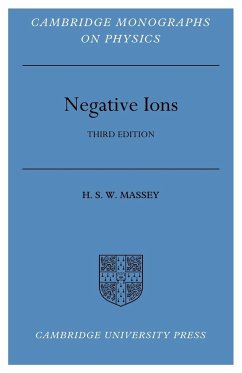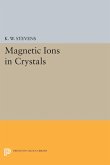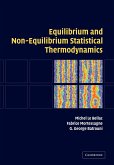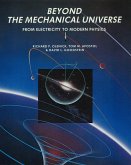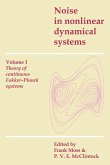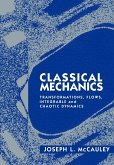Harrie Massey
Negative Ions
Harrie Massey
Negative Ions
- Broschiertes Buch
- Merkliste
- Auf die Merkliste
- Bewerten Bewerten
- Teilen
- Produkt teilen
- Produkterinnerung
- Produkterinnerung
This 1976 book reflects how advancing technology facilitated experimental work on the properties of negative ions in gases.
Andere Kunden interessierten sich auch für
![Magnetic Ions in Crystals Magnetic Ions in Crystals]() K. W. StevensMagnetic Ions in Crystals45,99 €
K. W. StevensMagnetic Ions in Crystals45,99 €![Vortex Dynamics Vortex Dynamics]() P. G. StaffmanVortex Dynamics65,99 €
P. G. StaffmanVortex Dynamics65,99 €![Equilibrium and Non-Equilibrium Statistical Thermodynamics Equilibrium and Non-Equilibrium Statistical Thermodynamics]() Michel Le BellacEquilibrium and Non-Equilibrium Statistical Thermodynamics75,99 €
Michel Le BellacEquilibrium and Non-Equilibrium Statistical Thermodynamics75,99 €![The Post-Darwinian Controversies The Post-Darwinian Controversies]() James R. MooreThe Post-Darwinian Controversies107,99 €
James R. MooreThe Post-Darwinian Controversies107,99 €![Beyond the Mechanical Universe Beyond the Mechanical Universe]() Richard P. OlenickBeyond the Mechanical Universe107,99 €
Richard P. OlenickBeyond the Mechanical Universe107,99 €![Noise in Nonlinear Dynamical Systems Noise in Nonlinear Dynamical Systems]() Noise in Nonlinear Dynamical Systems71,99 €
Noise in Nonlinear Dynamical Systems71,99 €![Classical Mechanics Classical Mechanics]() Joseph L. McCauleyClassical Mechanics107,99 €
Joseph L. McCauleyClassical Mechanics107,99 €-
-
-
This 1976 book reflects how advancing technology facilitated experimental work on the properties of negative ions in gases.
Hinweis: Dieser Artikel kann nur an eine deutsche Lieferadresse ausgeliefert werden.
Hinweis: Dieser Artikel kann nur an eine deutsche Lieferadresse ausgeliefert werden.
Produktdetails
- Produktdetails
- Verlag: Cambridge University Press
- Seitenzahl: 760
- Erscheinungstermin: 21. Februar 2011
- Englisch
- Abmessung: 216mm x 140mm x 40mm
- Gewicht: 938g
- ISBN-13: 9780521283175
- ISBN-10: 0521283175
- Artikelnr.: 33608533
- Herstellerkennzeichnung
- Libri GmbH
- Europaallee 1
- 36244 Bad Hersfeld
- gpsr@libri.de
- Verlag: Cambridge University Press
- Seitenzahl: 760
- Erscheinungstermin: 21. Februar 2011
- Englisch
- Abmessung: 216mm x 140mm x 40mm
- Gewicht: 938g
- ISBN-13: 9780521283175
- ISBN-10: 0521283175
- Artikelnr.: 33608533
- Herstellerkennzeichnung
- Libri GmbH
- Europaallee 1
- 36244 Bad Hersfeld
- gpsr@libri.de
Preface
1. Introduction - the negative ion of hydrogen (H-)
2. Ground states of complex atomic negative ions - theoretical considerations
3. The electron affinities of the elements
4. Atomic negative ions - excited states - autodetachment, general account
5. Autodetaching states of specific atomic negative ions
6. Molecular negative ions - grounds states
7. Excited electronic states of molecular negative ions
8. Modes of formation of negative ions - formation by radiative processes - radiative attachment and polar photodissociations
9. Modes of formation of negative ions - formation by three-body collisions of electrons - electron affinity
10. Formation of negative ions by capture of bound electrons
11. Detachment of electrons from negative ions - photodetachment, field detachment and detachment by electron impact
12. Detachment, charge transfer and other reactions between negative ions and neutral systems at low and intermediate energies
13. Detachment, charge transfer and other reactions involving negative ions- collisions at high impact energies
14. Recombinations of negative and positive ions - mutual neutralization
15. Negative ions in electric discharges, planetary and stellar atmospheres, trace analysis and tandem accelerators
References
Author index
Subject index.
1. Introduction - the negative ion of hydrogen (H-)
2. Ground states of complex atomic negative ions - theoretical considerations
3. The electron affinities of the elements
4. Atomic negative ions - excited states - autodetachment, general account
5. Autodetaching states of specific atomic negative ions
6. Molecular negative ions - grounds states
7. Excited electronic states of molecular negative ions
8. Modes of formation of negative ions - formation by radiative processes - radiative attachment and polar photodissociations
9. Modes of formation of negative ions - formation by three-body collisions of electrons - electron affinity
10. Formation of negative ions by capture of bound electrons
11. Detachment of electrons from negative ions - photodetachment, field detachment and detachment by electron impact
12. Detachment, charge transfer and other reactions between negative ions and neutral systems at low and intermediate energies
13. Detachment, charge transfer and other reactions involving negative ions- collisions at high impact energies
14. Recombinations of negative and positive ions - mutual neutralization
15. Negative ions in electric discharges, planetary and stellar atmospheres, trace analysis and tandem accelerators
References
Author index
Subject index.
Preface
1. Introduction - the negative ion of hydrogen (H-)
2. Ground states of complex atomic negative ions - theoretical considerations
3. The electron affinities of the elements
4. Atomic negative ions - excited states - autodetachment, general account
5. Autodetaching states of specific atomic negative ions
6. Molecular negative ions - grounds states
7. Excited electronic states of molecular negative ions
8. Modes of formation of negative ions - formation by radiative processes - radiative attachment and polar photodissociations
9. Modes of formation of negative ions - formation by three-body collisions of electrons - electron affinity
10. Formation of negative ions by capture of bound electrons
11. Detachment of electrons from negative ions - photodetachment, field detachment and detachment by electron impact
12. Detachment, charge transfer and other reactions between negative ions and neutral systems at low and intermediate energies
13. Detachment, charge transfer and other reactions involving negative ions- collisions at high impact energies
14. Recombinations of negative and positive ions - mutual neutralization
15. Negative ions in electric discharges, planetary and stellar atmospheres, trace analysis and tandem accelerators
References
Author index
Subject index.
1. Introduction - the negative ion of hydrogen (H-)
2. Ground states of complex atomic negative ions - theoretical considerations
3. The electron affinities of the elements
4. Atomic negative ions - excited states - autodetachment, general account
5. Autodetaching states of specific atomic negative ions
6. Molecular negative ions - grounds states
7. Excited electronic states of molecular negative ions
8. Modes of formation of negative ions - formation by radiative processes - radiative attachment and polar photodissociations
9. Modes of formation of negative ions - formation by three-body collisions of electrons - electron affinity
10. Formation of negative ions by capture of bound electrons
11. Detachment of electrons from negative ions - photodetachment, field detachment and detachment by electron impact
12. Detachment, charge transfer and other reactions between negative ions and neutral systems at low and intermediate energies
13. Detachment, charge transfer and other reactions involving negative ions- collisions at high impact energies
14. Recombinations of negative and positive ions - mutual neutralization
15. Negative ions in electric discharges, planetary and stellar atmospheres, trace analysis and tandem accelerators
References
Author index
Subject index.

